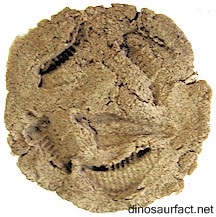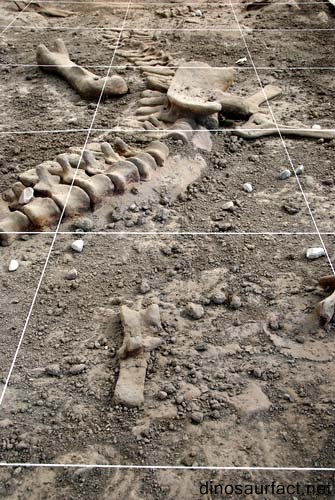 Click to visit the previous dinosaur bio
Click to visit the previous dinosaur bio
 |
|
 |
|
Kingdom: Animalia
Phylum: Chordata
Class: Sauropsida
Superorder: Dinosauria
Order: Saurischia
Suborder: Sauropodomorpha
Infaorder: Prosauropoda
Genus: Ruehleia
 |
|
 |
|
 |
|

The Ruehleia was a prosauropod dinosaur whose remains were discovered in Germany. It was extant about 215 to 205 million years ago in the Norian age of the Triassic period of the Mesozoic era.
The size of the Ruehleia was moderate to large as compared to other prosauropods. It adult size is estimated to be about 6 to 8 meters in length. Its body weight could have been between 500 to 1000 kilos. Its height could possibly have been 2 to 3 meters.
The fossils of the Ruehleia were initially thought to belong to the Plateosaurus. This was due to the discrepancies in understanding the sacrum of the remains. But further investigations revealed that they belonged to a completely different species of dinosaur.
Etymology
The name Ruehleia was coined by paleontologist Peter Galton. The fossils were originally thought belong to the Plateosaurus and they were reassigned by Galton in 2001. The nomenclature was chosen to honor the fossil collector Ruehle von Lilienstern who excavated the fossils in 1952. The suffix '-ia' indicates ‘of Ruehle’ or ‘belonging to Ruehle’.
The binomial name Ruehleia bedheimensis points out to the town of Bedheim from where Lilienstern hailed.
Discovery of fossils
The fossils ascribed today as the Ruehleia were discovered in Knollenmergel Romhild in Germany. They were found in the Trossingen Formation in an area 10 miles away from Schleusingen.
The remains were unearthed by Ruehle von Lilienstern. They were handed over to Friedrich von Huene for examination.
Nature of remains
An extensive number of fossils, now recognized as the Ruehleia, were uncovered in Germany in 1952. They included the cervical and thoracic vertebrae, along with certain lumbar vertebrae and the sacrum. Many of the long bones of the extremities were also discovered. Furthermore, some rib, carpals and metacarpals were also found.
The skull bones were noticeably missing from the remains.
Classification
- Almost the entire skeleton of the Ruehleia was discovered in 1952. Yet the fossils were wrongly categorized for almost fifty years. The reason for this misunderstanding originated from the sacral bone.
- Friedrich von Huene on his initial examination classified the remains now attributed to the Ruehleia to the Plateosaurus plieningeri. Prosauropods usually have three sacral vertebrae. These were made up of two sacral vertebrae and one extra fused vertebra at the cranial end (from the lumbar side) or at the caudal end (the coccygeal side).
- The fossils of the Plateosaurus pleiningeri were thought to have the additional cranial sacral vertebra like the other Plateosaurus species. But on closer examination, Galton saw that the remains had an additional caudal sacral vertebra. This modification in the sacral bone indicated that the fossils belonged to a completely new dinosaur genus.
- Along with the aforementioned differences, the pelvic bones and the forearm bones of the remains were incongruent to the other Palteosaurus species.
Thus, Galton reclassified the Plateosaurus plieningeri as the Rueleia bedheimensis.
The Trossingen Formation
The Trossingen Formation is a natural rock formation which is a part of the Keuper group of Germany. The Kueper group is an extensive geological structure consisting of many subgroups such as the Upper, Midle and Lower Kueper.
- The Trossingen Formation has fossils from the Norian to the Rhaetian ages of the Triassic period.
- It is composed of uniform rock layers which consist primarily of shale stones. These are usually red, sometimes purple in color. Limestone deposits are also seen in certain parts of the Trossingen formation.
- The average thickness of the formation is 50 meters. However, it thins out to become 10 meters deep in certain regions adjoining the Lowenstein Formation.
- Many vertebrate and invertebrate fossils were discovered in the Trossingen Formation. These include dinosaurs such as the Plateosaurus and Rhueleia, along with mussels, ostracods and other aquatic flora and fauna.
Huele von Lilienstern and Peter Galton
- Huele von Lilienstern:
- von Lilienstern was a German fossils hunter with no professionals training in paleontology. He had performed extensive searches in Germany and had uncovered many different ancient remains.
- Many dinosaur species have been name in his honor, like the Liliensternus liliensterni and the Ruehleia bedheimensis.
- Peter Galton:
- Galton is a contemporary vertebrate scientist. He is British by origin.
- His views about the evolution of dinosaurs which have been expressed in several publications and journals which have been instrumental in shaping the modern ideas about clade Dinosauria.
- Galton has extensively studied the remains of the Plateosaurus. His other works include study of the remains of the Kentrosaurus, the Hypsilophodon and other ornithischian and hadrosaurian dinosaurs.
Current location of fossils
The remains of the Ruehleia are presently preserved in the Naturkunde Museum in Berlin, Germany.
Physical characteristics
- The Ruehleia was a large dinosaur as compared to other prosauropods. Its length was about 25 to 30 feet. Its final size could have been anything between 0.5 to 2 metric tons.
- It was an obligatory bipedal dinosaur. Its forelimbs were significantly shorter than its hind legs. It could grasp vegetation with its forelegs.
- The Ruehleia could possibly have touched all four of its legs simultaneously on the ground while eating or drinking water.
- Its neck was long and flexible like other prosauropods.
- Its hind limbs were stout and powerful, as indicated by its bones.
Habits and habitat
The feeding habits of the Ruehleia were herbivorous. It fed on shrubs and other small plants that flourished abundantly in its environment.
The habitat of the Ruehleia consisted of lakes and marshes. These probably dried up when the rainfall had receded, but the vegetation was most likely lush all year round.
Related and coexisting species
As indicated by its fossils, the Ruehleia was closely related to the Plateosaurus. It possibly could have co-existed with the Plateosaurus.
It possibly could have coexisted with the Zanclodon.
Epilogue
In spite of almost the entire skeleton being discovered, the classification of the Ruehleia had been a trying task. As most of its features were characteristic prosauropod, and they were very much akin the Plateosaurus, it was grouped as a species of genus Plateosaurus.
When the bones were examined more carefully, many features were seen that distinguished the remains from the Plateosaurus.
The Ruehleia was a very typical intermediate dinosaur with features resembling both prosauropods and true sauropods. These two types of dinosaurs may have evolved sequentially or may have had some common ancestor. The Ruehleia heralded the dominance of the massive sauropods of the Jurassic period.
Index
Extinct Profiles
 Triassic Dinosaurs
Triassic Dinosaurs Jurassic Dinosaurs
Jurassic Dinosaurs Cretaceous Dinosaurs
Cretaceous Dinosaurs Pterosaurs
Pterosaurs Marine Reptiles
Marine Reptiles Dinosaur Extinction
Dinosaur Extinction